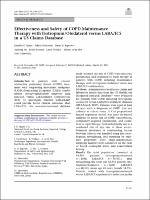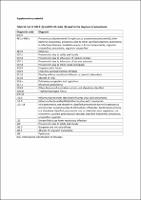| dc.contributor | Vall d'Hebron Barcelona Hospital Campus |
| dc.contributor.author | Quint, Jennifer K. |
| dc.contributor.author | Montonen, Jukka |
| dc.contributor.author | Esposito, Daina B. |
| dc.contributor.author | He, Xintong |
| dc.contributor.author | Koerner, Leslie |
| dc.contributor.author | Wallace, Laura |
| dc.contributor.author | Miravitlles Fernández, Marc |
| dc.date.accessioned | 2022-03-10T07:40:53Z |
| dc.date.available | 2022-03-10T07:40:53Z |
| dc.date.issued | 2021-05 |
| dc.identifier.citation | Quint JK, Montonen J, Esposito DB, He X, Koerner L, Wallace L, et al. Effectiveness and Safety of COPD Maintenance Therapy with Tiotropium/Olodaterol versus LABA/ICS in a US Claims Database. Adv Ther. 2021 May;38:2249–2270. |
| dc.identifier.issn | 1865-8652 |
| dc.identifier.uri | https://hdl.handle.net/11351/7133 |
| dc.description | Malaltia pulmonar obstructiva crònica; Corticosteroides; Olodaterol |
| dc.description.sponsorship | Support for this project and the journal’s Open Access Fee were funded by Boehringer Ingelheim International GmbH. No Rapid Service Fee was received by the journal for the publication of this article. |
| dc.language.iso | eng |
| dc.publisher | Springer |
| dc.relation.ispartofseries | Advances in Therapy;38 |
| dc.rights | Attribution-NonCommercial 4.0 International |
| dc.rights.uri | http://creativecommons.org/licenses/by-nc/4.0/ |
| dc.source | Scientia |
| dc.subject | Pulmons - Malalties obstructives - Tractament |
| dc.subject | Avaluació de resultats (Assistència sanitària) |
| dc.subject | Farmacologia respiratòria |
| dc.subject.mesh | Pulmonary Disease, Chronic Obstructive |
| dc.subject.mesh | /drug therapy |
| dc.subject.mesh | Treatment Outcome |
| dc.subject.mesh | Tiotropium Bromide |
| dc.title | Effectiveness and Safety of COPD Maintenance Therapy with Tiotropium/Olodaterol versus LABA/ICS in a US Claims Database |
| dc.type | info:eu-repo/semantics/article |
| dc.identifier.doi | 10.1007/s12325-021-01646-5 |
| dc.subject.decs | enfermedad pulmonar obstructiva crónica |
| dc.subject.decs | /farmacoterapia |
| dc.subject.decs | resultado del tratamiento |
| dc.subject.decs | bromuro de tiotropio |
| dc.relation.publishversion | https://doi.org/10.1007/s12325-021-01646-5 |
| dc.type.version | info:eu-repo/semantics/publishedVersion |
| dc.audience | Professionals |
| dc.contributor.organismes | Institut Català de la Salut |
| dc.contributor.authoraffiliation | [Quint JK] National Heart and Lung Institute, Imperial College London, London, UK. [Montonen J, Wallace L] Boehringer Ingelheim International GmbH, Ingelheim am Rhein, Germany. [Esposito DB, He X, Koerner L] Department of Safety and Epidemiology, HealthCore, Inc, Watertown, MA, USA. [Miravitlles M] Servei de Pneumologia, Vall d’Hebron Hospital Universitari, Barcelona, Spain. Vall d’Hebron Institut de Recerca (VHIR), Barcelona, Spain. CIBER de Enfermedades Respiratorias (CIBERES), Barcelona, Spain |
| dc.identifier.pmid | 33721209 |
| dc.identifier.wos | 000629189600001 |
| dc.rights.accessrights | info:eu-repo/semantics/openAccess |


